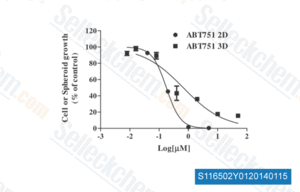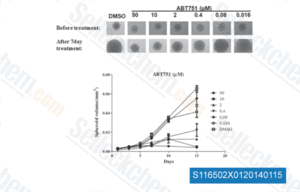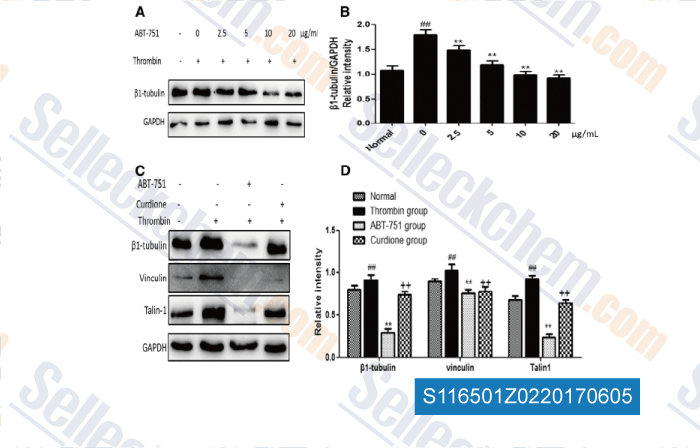|
Toll Free: (877) 796-6397 -- USA and Canada only -- |
Fax: +1-832-582-8590 Orders: +1-832-582-8158 |
Tech Support: +1-832-582-8158 Ext:3 Please provide your Order Number in the email. |
Technical Data
| Formula | C18H17N3O4S |
||||||
| Molecular Weight | 371.41 | CAS No. | 141430-65-1 | ||||
| Solubility (25°C)* | In vitro | DMSO | 74 mg/mL (199.24 mM) | ||||
| Ethanol | 12 mg/mL (32.3 mM) | ||||||
| Water | Insoluble | ||||||
| In vivo (Add solvents to the product individually and in order) |
|
||||||
|
* <1 mg/ml means slightly soluble or insoluble. * Please note that Selleck tests the solubility of all compounds in-house, and the actual solubility may differ slightly from published values. This is normal and is due to slight batch-to-batch variations. * Room temperature shipping (Stability testing shows this product can be shipped without any cooling measures.) |
|||||||
Preparing Stock Solutions
Biological Activity
| Description | ABT-751 (E7010) binds to the colchicine site on β-tubulin and inhibits polymerization of microtubules, not a substrate for the MDR transporter and is active against cell lines resistant to vincristine, doxorubicin, and cisplatin. Phase 1/2. | |
|---|---|---|
| Targets |
|
|
| In vitro | In vitro, ABT-751 shows the selective cytotoxicity with IC50 of 0.6–2.6 μM in neuroblastoma and 0.7–4.6 μM in other solid tumor cell lines. Furthermore, ABT-751 also exhibits a selective effect on dynamic microtubules and spares stable microtubules, accounting for the persistence of acetylated and detyrosinated α-tubulin positive polymerized tubules at the IC90 concentration of ABT-751. [1] | |
| In vivo | In this Calu-6 xenograft model, ABT-751 as a single agent at 100 and 75 mg/kg/day shows significant antitumor activity, while in combination with cisplatin, ABT-751 shows a dose-dependent enhancement in growth delay. In the HT-29 colon xenograft model, ABT-751 also shows significant antitumor activity as a single agent and produced a dose-dependent enhancement in growth delay In combination with 5-FU. [2] In dogs with lymphoma, ABT-751 exhibits the dose-limiting toxicities that included vomiting, diarrhea, anorexia, or some combination of these with a maximum tolerated dose (MTD) of 350 mg/m2 PO q24h. Furthermore, the mean AUC and Cmax for ABT-751 at the MTD of 350 mg/m2 is 5.55 μg-hour/mL and 0.9 μg/mL, respectively. [3] | |
| Features | An orally bioavailable tubulin-binding and antimitotic sulfonamide. |
Protocol (from reference)
| Cell Assay:[1] |
|
|---|---|
| Animal Study:[2] |
|
References
|
Customer Product Validation

-
Data from [Data independently produced by Bioorg Med Chem, 2013, 21, 922-31]

-
Data from [Data independently produced by Bioorg Med Chem, 2013, 21, 922-31]

-
Data from [Data independently produced by , , Fitoterapia, 2017, 116:106-115]
Selleck's ABT-751 (E7010) has been cited by 5 publications
| TGFβ-induced epigenetic deregulation of SOCS3 facilitates STAT3-signaling to promote fibrosis. [ J Clin Invest, 2020, 10.1172/JCI122462] | PubMed: 31990678 |
| Curdione attenuates thrombin-induced human platelet activation: β1-tubulin as a potential therapeutic target. [Zhang D, et al. Fitoterapia, 2017, 116:106-115] | PubMed: 27915054 |
| Gain- and Loss-of-Function Mutations in the Breast Cancer Gene GATA3 Result in Differential Drug Sensitivity [ PLoS Genet, 2016, 12(9):e1006279] | PubMed: 27588951 |
| Bioluminescent cell-based NAD(P)/NAD(P)H assays for rapid dinucleotide measurement and inhibitor screening [ Assay Drug Dev Technol, 2014, 12(9-10):514-26] | PubMed: 25506801 |
| Development, validation and pilot screening of an in vitro multi-cellular three-dimensional cancer spheroid assay for anti-cancer drug testing. [Rati Lama, et al. Bioorg Med Chem, 2013, 21(4):922-31] | PubMed: 23306053 |
RETURN POLICY
Selleck Chemical’s Unconditional Return Policy ensures a smooth online shopping experience for our customers. If you are in any way unsatisfied with your purchase, you may return any item(s) within 7 days of receiving it. In the event of product quality issues, either protocol related or product related problems, you may return any item(s) within 365 days from the original purchase date. Please follow the instructions below when returning products.
SHIPPING AND STORAGE
Selleck products are transported at room temperature. If you receive the product at room temperature, please rest assured, the Selleck Quality Inspection Department has conducted experiments to verify that the normal temperature placement of one month will not affect the biological activity of powder products. After collecting, please store the product according to the requirements described in the datasheet. Most Selleck products are stable under the recommended conditions.
NOT FOR HUMAN, VETERINARY DIAGNOSTIC OR THERAPEUTIC USE.
